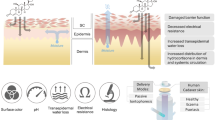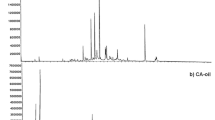Abstract
Purpose. Evaluation of skin layer-specific prednicarbate (PC) biotransformation, possibly explaining the improved benefit/risk ratio of this topical corticosteroid in atopic dermatitis (1,2).
Methods. Metabolism of PC in keratinocyte and fibroblast monolayers derived from human juvenile foreskin was evaluated. Drug concentration was determined by HPLC/UV-absorption. Accompanying cell viability tests (MTT-tests) were performed to exclude toxic drug effects.
Results. Keratinocytes hydrolyzed the double ester PC (2.5 × 10−6 M) at position 21 to the monoester prednisolone 17-ethylcarbonate (P17EC) which nonenzymatically transformed to prednisolone 21-ethylcarbonate (P21EC). This metabolite was enzymatically cleaved to prednisolone (PD), the main biotransformation product at 24 hours. Fibroblasts, however, showed a distinctively lower enzyme activity. Both, PC and P17EC (or rather P21EC) were hydrolyzed to a minor extent only. The biotransformation pathway, however, was the same. When P17EC was added separately, it transformed to P21EC and again was cleaved by keratinocytes to a much higher extent. Despite of the rather high glucocorticoid concentration MTT-tests proved a non-disturbed cell viability and proliferation rate.
Conclusions. Extrapolating our results to the in-vivo situation, topically applied PC may be metabolized by epidermal cells during skin penetration. A complex mixture of compounds reaches the dermis, whose fibroblasts are barely able to metabolize the steroids. Since skin atrophy is less pronounced with PC as compared to conventional halogenated glucocorticoids, less potent PC metabolites appear to be the dominant species in the dermis.
Similar content being viewed by others
REFERENCES
H. C. Korting, D. Vieluf, and M. J. Kerscher. Eur. J. Pharmacol. 42:159–61 (1992).
M. J. Kerscher and H. C. Korting. Acta Derm. Venereol. 72:214–16 (1992).
D. B. Robertson and H. I. Maibach. In R. P. Schleimer, H. N. Claman, and A. Oronsky (eds.), Anti-inflammatory steroid action, Academic Press, San Diego, 1989, pp. 494–524.
M. Schäfer-Korting, M.-H. Schmid, and H. C. Korting. Drug Safety 14:375–385 (1996).
M. Schäfer-Korting and A. Gysler. In H. C. Korting, and M. Schäfer-Korting (eds.), The benefit/risk ratio: A handbook for the rational use of potentially hazardous drugs, CRC Press, Boca Raton, Florida, (in press).
M. Schäfer-Korting, H. C. Korting, M. J. Kerscher, and S. Lenhard. Clin. Pharmacol. Ther. 54:448–456 (1993).
M. J. Kerscher and H. C. Korting. Skin Pharmacol. 5:77–80 (1992).
A. Aliaga, M. Rodríguez, M. Armijo, J. Bravo, A. López Avila, J. M. Mascaro, J. Ferrando, R. Del Rio, R. Lozano, and A. Balaguer. Int. J. Dermatol. 35:131–132 (1996).
H. J. Vogt and T. Höhler. In C. Christophers, E. Schöpf, A. M. Kligman, and R. B. Stoughton (eds.), Topical corticosteroid therapy. A novel approach to safer drugs, Raven Press, New York, 1988, pp. 169–79.
R. Hein, H. C. Korting, and T. Mehring. Skin Pharmacol. 7:300–306 (1994).
H. C. Korting, E. Hülsebus, M. Kerscher, R. Greber, and M. Schäfer-Korting. Br. J. Dermatol. 133:54–59 (1995).
C. M. Bamberger, A.-M. Bamberger, M. de Castro, and G. P. Chrousos. J. Clin. Invest. 95:2435–41 (1995).
J. Barth, K. H. Lehr, H. Derendorf, H. W. Möllmann, Th. Höhler, and G. Hochhaus. Skin Pharmacol. 6:179–186 (1993).
K. H. Kim and N. L. Henderson. In E. Christophers, E. Schöpf, A. M. Kligman, and R. B. Stoughton (eds.), Topical corticosteroid therapy. A novel approach to safer drugs, Raven Press, New York, 1988, pp. 49–56.
H.-M. Kellner, H. G. Eckert, H. W. Fehlhaber, I. Hornke, and R. Oekonomopulos. Z. Hautkr. 61:18–40 (1986).
G. Würthwein, S. Rehder, and P. Rohdewald. Pharmazeutische Zeitung Wissenschaft 4:161–166 (1992).
M. Pagé, N. Bejaoui, B. Cinq-Mars, and P. Lemieux. Int. J. Immunopharmacol. 10:785–793 (1988).
R. D. Carr and R. G. Wieland. Arch. Dermatol. 94:81–84 (1966).
Author information
Authors and Affiliations
Rights and permissions
About this article
Cite this article
Gysler, A., Lange, K., Korting, H.C. et al. Prednicarbate Biotransformation in Human Foreskin Keratinocytes and Fibroblasts. Pharm Res 14, 793–797 (1997). https://doi.org/10.1023/A:1012162708675
Issue Date:
DOI: https://doi.org/10.1023/A:1012162708675




